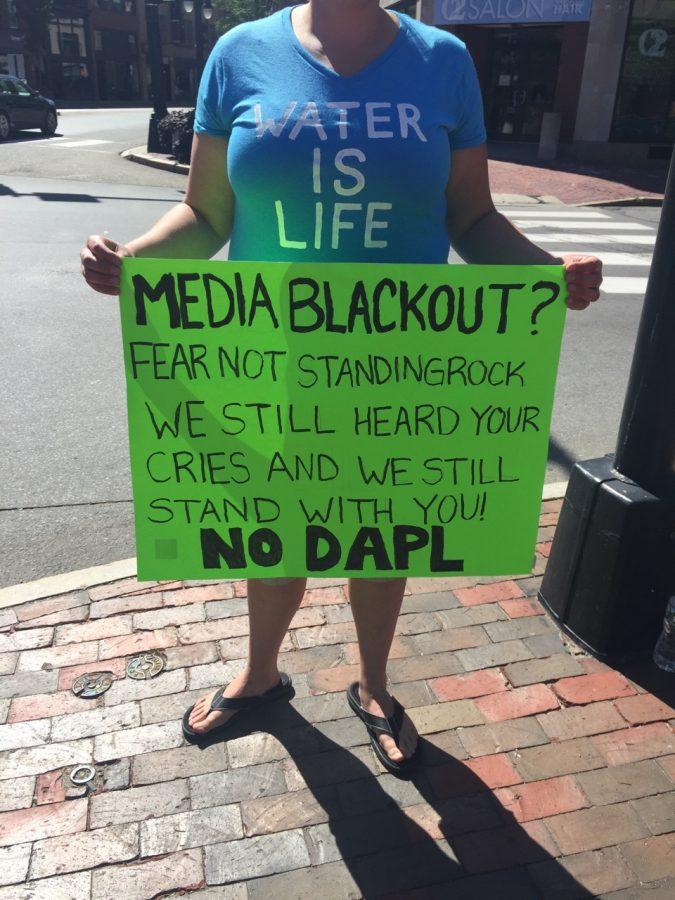For Those Who Stood with Standing Rock
December 9, 2016
A little over a year ago, the name Standing Rock Sioux wouldn’t draw much attention but since April of this year, they and their reservation in the Dakotas have become a household name. On March 11, 2016, the Iowa Utilities Board became the fourth and final state to approve a pipeline spanning 1,172 miles proposed by Dakota Access LLC. This would become known as the Dakota Access Pipeline, or DAPL for short. The $3.8 billion project cut its way through Lake Oahe, a sacred site on the Standing Rock reservation. This caught the attention of the local tribes who rode on horseback as protest and petitioned the Army Corps of Engineers to study the environmental impacts the pipeline would have further. When this did not help, the Sioux sued to no avail. As tensions flared, the project began to gain traction in the media and tribes across the nation and world, along with environmentalists, began to help spread the word about DAPL, the impacts it would have, and the fight to stop it.
On September 17, masses gathered in Portland to voice their opinion on the Dakota Access Pipelines. Around this time, the project began to pick up a little more media attention than it had been getting in the past weeks. As we stood in the crowd, leaders and figures from local native tribes led the crowd with a simple message in mind, “mni wiconi, water is life.” They sang, they prayed, and they told stories that have been passed from generation to generation. One of which was the Lakota Sioux prophecy of Zuzeca Sape, the black snake. The old prophecy speaks of the black snake crossing over the land and bringing devastation with it and for many, the black snake has taken form as the proposed pipeline. Sherri Mitchell, a member of Maine’s Passamaquoddy tribe, stated, “we were told generations ago that there would come a time that this black snake would move across the land…everybody is pretty clear now that they were referring to these pipelines.” A donation box was sent around for members of the tribes who would be traveling out to the Scared Stone Camp of the Standing Rock reservation in North and South Dakota, ground zero of the fight to end DAPL. The peaceful protest was extremely emotional. One student who attended called it “enlightening, culturally competent, and thought provoking.”
In the time since my participation in the protest, tensions have rose, those standing have done so strongly, and victories have been made. News has recently broken that protesters were being doused by water cannons, even in subfreezing temperatures, shot with rubber bullets, and were subjected to tear gasses. The local sheriff’s department justified these tactics by calling what was happening an “ongoing riot” even though protesters have refused these statements. You may have seen friends checking into Standing Rock or Sacred Stone on Facebook over the last few weeks. This tactic was used to help protect protesters as it was alleged that law enforcement was using their check-ins to find personal information on them. Those who were arrested describe being put into “concentration camp” like conditions, having numbers written on their arms as identification and kept in holding cells that resembled fence dog kennels. Early on in the protests, those who showed up were maced and had guard dogs sent out on them by private security. But none of this stopped the so-called “water protesters.” “We are protectors, not protestors,” Iyuskin American Horse who is Sicangu and Oglala Lakota stated, “…this camp was created as a last defense for the water that our communities depend on to survive.”
Only days ago, defying orders to disperse, two-thousand American veterans, some members of tribes themselves, joined those in Standing Rock to help give them a break as harsh winter weather began to set in. Many claimed they were there to fight to protect what they fought for overseas. But on December 4th, news broke that the Army Corps of Engineers blocked construction of the pipeline further by denying a permit to build under Lake Oahe. Celebrations instantly erupted among the members of the camp. Even if this wasn’t the win to end the war, it was a significant, historic victory and none of it could have been done without those who fought against DAPL. So, to those who stood with Standing Rock, this could not have been done without you. No change would have been made if two hundred people didn’t ride on horseback to the site of the proposed construction to spark the beginning of the fight to end DAPL. The construction would not have been paused if you hadn’t tirelessly spread the word, provided support, and spoke up, even when it got difficult. This win was for the millions of Native Americans and their ancestors who suffered through unspeakable oppression, for the people who allied with them, for those who believe in the principle that “water is life” and in access to clean water being a right, and for our future. The struggle isn’t over, however. This is just the first step to ending the project, but for now we can celebrate what we have.



